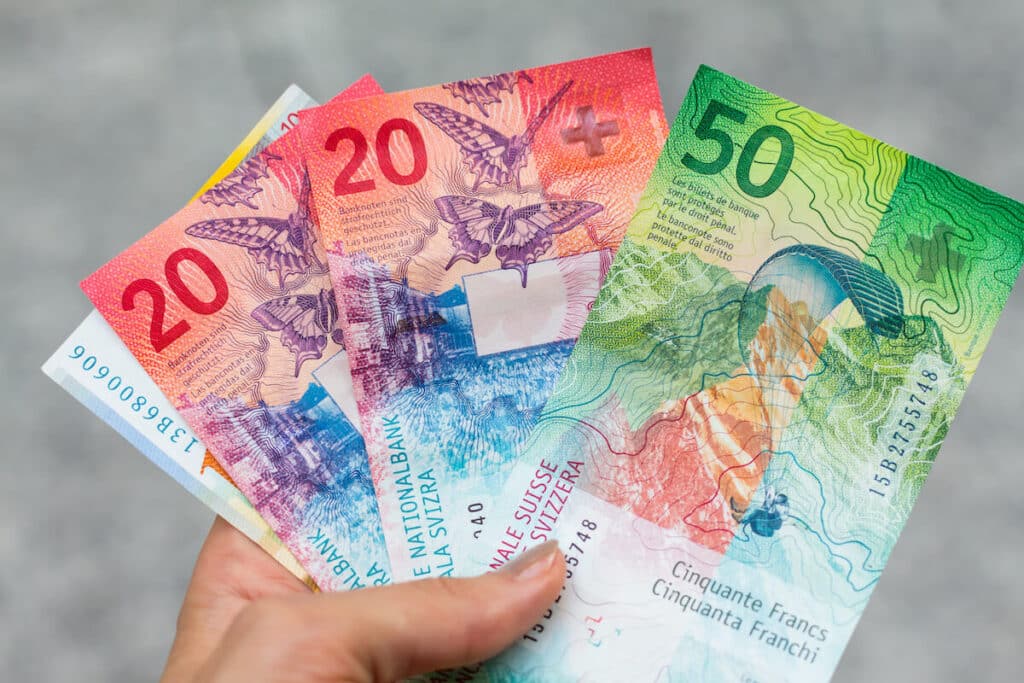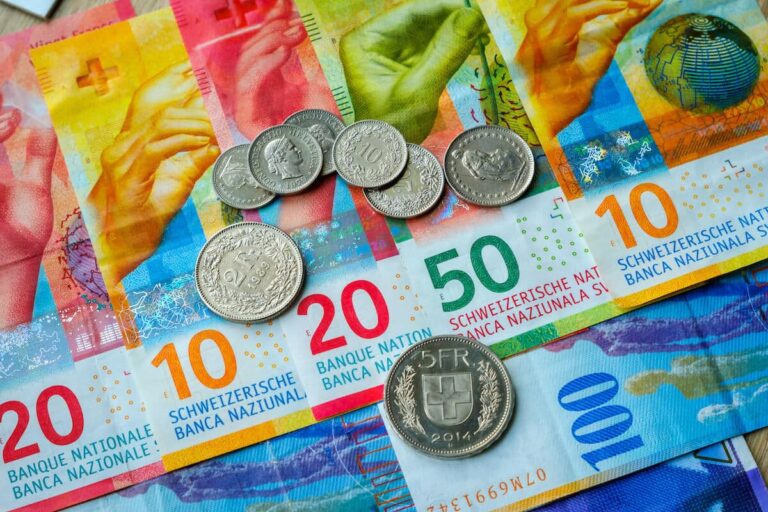Switzerland has built its reputation as a banking powerhouse, with cities like Zurich and Geneva topping the list of the world’s largest financial centers. That’s partly due to the strength of the Swiss franc, Switzerland’s official currency.
But how did the Swiss franc become one of the world’s most-traded currencies? And what do you need to know if you plan to send money to Switzerland?
Here’s our guide to the currency of Switzerland, including the history of the Swiss franc and how to get the best CHF currency exchange rate.
The history of Swiss currency
Switzerland is a country located in the middle of Europe, but it isn’t part of the European Union (EU). It has its own currency, the Swiss franc, and doesn’t use the euro (EUR).
Officially called the Swiss Confederation, Switzerland consists of 26 cantons (states), all which have some degree of autonomy and use one of four national languages: French, Italian, German, and Romansh.
This makes the history of Swiss currency and its circulation an especially fascinating one. One visitor in the 1800s wrote, “There is hardly a country in Europe which has so complicated a Currency as Switzerland; almost every Canton has a coinage of its own.”
There was the Bern livre, the South German gulden, and the florin petite monnaie in Geneva. The French franc and German kronenthaler were common too.
This changed in 1848, when the new Swiss Constitution declared that only the central bank could issue Swiss currency. The Federal Coinage Act of 1850 confirmed that the franc would be the official currency of Switzerland.
Swiss franc denominations: Coins and banknotes
These days, the Swiss franc is remarkably stable, and many investors choose it as a safe haven currency, alongside the U.S. dollar (USD) and the Japanese yen (JPY).
You’ll find Swiss franc banknotes in the following denominations: 10, 20, 50, 100, 200, and 1,000 francs, and occasionally 500 francs.
Swiss coins come in 5, 10, and 20 centimes, as well as ½-, 1-, 2-, and 5-franc coins. Each language has its own name for the subunits. It’s centime in French, rappen in German, centesimo in Italian, and rap in Romansh.
According to the Swiss National Bank (SNB), the most recent banknotes are replacing the faces of famous figures with depictions of “the many facets of Switzerland.” These banknotes are made of cotton and polymer, and have over a dozen security features, including special inks, threads, and “microtext.”
6 key facts about the Swiss franc
Whether you’re visiting Switzerland, need to send money there, or are just curious, here are six key facts to help you appreciate the unique history of Swiss currency.
1. The currency code (CHF) comes from Latin.
When you look up the Swiss franc using a currency converter, you might be surprised to find that its currency code is CHF. Where do those letters come from?
The letters CHF come from the words “Confoederatio Helvetica franc”—that’s the name of the Swiss Confederation in Latin.
The Swiss franc doesn’t have a currency symbol (like the dollar sign) so in most cases, you’ll identify it using the letters CHF or the abbreviation Fr.
2. The Swiss franc is the last franc in Europe.
Until recently, the franc was a common currency in Europe. It originated in France and was the official currency in Belgium and Luxembourg for many years. Now, all of those countries are part of the EU and use the euro.
Switzerland is the only European country that still issues the franc. However, several countries in Africa use a version of the CFA franc.
3. Swiss currency is the eighth-most-traded currency.
As of 2022, CHF currency is the eighth-most-traded currency in the world, not far behind the U.S. dollar (USD), the British pound (GBP), and the Australian dollar (AUD). The Swiss franc accounted for around 5% of all foreign exchange transactions in 2022.
4. The CHF was previously pegged to foreign currencies.
Switzerland has changed its monetary policy several times since it introduced the Swiss franc. The first Swiss franc was issued at par with the French franc.
In 1865, Switzerland joined the Latin Monetary Union, along with France, Belgium, and Italy. For over 60 years, they maintained a common value across their currencies.
In 2011, the Swiss National Bank took the step of capping the Swiss franc exchange rate at 1.20 CHF to 1 EUR. This controversial policy ended in 2015.
5. Swiss currency is (partially) backed by gold.
Switzerland removed the gold standard in 1999—by vote. Previously, the central bank held 40% of its reserves in gold, but voters removed that requirement in 1999.
They voted against expanding the gold reserves again in 2014, leaving them at around 7% of the central bank’s current assets.
6. The Swiss franc is the official currency of Liechtenstein.
Switzerland isn’t the only country where you can spend the Swiss franc. Liechtenstein doesn’t issue its own currency, so the Swiss franc is legal tender there.
There’s also a town in Italy that uses the Swiss franc. Campione d’Italia is an enclave, meaning it’s entirely surrounded by Switzerland, and the locals use Swiss currency.
Circulation of the Swiss franc
The Swiss franc is not only the legal tender of Switzerland but also enjoys significant circulation in Liechtenstein and the Italian exclave of Campione d’Italia. The Swiss National Bank (SNB) is responsible for issuing the currency, ensuring a stable supply that meets the needs of the economy. As of 2010, the total value of released Swiss coins and banknotes was approximately 49.664 billion Swiss francs, with coins being legal tender for amounts up to 100 coins, while banknotes are accepted for any sum. This widespread acceptance and stable issuance contribute to the Swiss franc’s reputation as a reliable and safe currency.
The circulation of the Swiss franc is further bolstered by its status as a safe-haven currency, often sought after during periods of economic instability. It accounted for about 5% of all foreign exchange transactions in 2022, making it the eighth-most-traded currency globally. The SNB’s careful management of the currency supply, alongside its commitment to monetary stability, ensures that the Swiss franc remains an integral part of both domestic and international financial systems.
Exchanging and using the Swiss franc

Switzerland is one of the world’s most advanced economies—but it also has a compared to other European countries. If you’re thinking of visiting Switzerland or moving there, it’s a good idea to have a plan for how you’ll spend your money.
First, do you need to exchange your home currency into Swiss francs? In most cases, yes. Some tourist establishments may accept the euro, but they’ll give you change in the local currency, and you may not get the best exchange rate.
Do you need to carry cash? Not necessarily. While it’s a good idea to carry cash if you’ll be visiting small towns, many businesses accept debit cards and credit cards, and you should be able to withdraw cash from ATMs if you need to.
Of course, you’ll want to find out if your bank or credit card charges foreign transaction fees. If so, consider sending money to Switzerland in advance.
CHF currency exchange rates
Whenever you transfer money overseas, it’s important to look up the exchange rate to make sure you’re getting the best deal for your money. Although the franc is relatively stable, 1 CHF may fluctuate in value over time compared to other currencies.
Check the rate for each currency pair that you want to convert (such as the Canadian dollar to CHF) to find out the current exchange rate.
You’ll also want to look for an international money transfer service that has transparent pricing, so you don’t pay more than you need to.
Live currency rates and central bank rates
In today’s interconnected world, staying updated with the latest news and fluctuations in currency exchange rates is crucial, especially for those dealing with the Swiss franc. The Swiss National Bank (SNB) plays a vital role in this ecosystem by providing real-time data on the CHF’s performance against major currencies. As a result, individuals and businesses can make informed decisions when exchanging or investing in Swiss francs.
To monitor the latest currency rates, various financial platforms offer live updates, allowing users to track the CHF’s value against currencies like the US dollar (USD) and euro (EUR). These platforms often feature analytical tools to help users understand market trends and potential shifts in exchange rates. By keeping an eye on the latest news and central bank rate adjustments, you can better assess the optimal times for currency conversion or investment in the Swiss franc.
CHF to USD
Find CHF exchange rates online easily from a free calculator, or log into your favorite money transfer app to find out what the current CHF rate is for that service.
CHF to EUR
With online tools or a money transfer app like Remitly, you can also see current EUR – USD rates. Euros are accepted across Switzerland, including at major hotels. When you pay cash, you will receive change in Swiss francs, however.
Swiss franc stats and profile
Various metrics illuminate the significance of the Swiss franc within the global financial institutions landscape. The currency holds the CHF code, emphasizing its roots in the Latin nomenclature. Notably, financial institutions regard the franc as a safe haven asset, particularly in turbulent times. It is the eighth-most-traded currency worldwide, enhancing its appeal in forex markets. The Swiss National Bank plays a crucial role in regulating its circulation, maintaining a stable exchange rate against major currencies like the euro and USD.
Send money to a bank account in Switzerland

Remitly is a money transfer app that lets you send money to friends and family around the world, with fast speeds and transparent pricing. You can fund your transfer with a debit card or credit card, and you can track its progress using the Remitly mobile app.
If you need to send money to Switzerland, you have two delivery options: bank deposit or debit card deposit. The recipient can receive the money into their account with UBS, CreditSuisse, or another local bank.
Simply provide their account or debit card details, and Remitly will take care of the rest.
Download the app now to get started!
